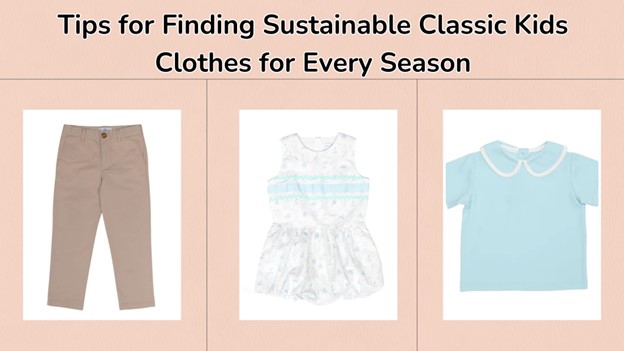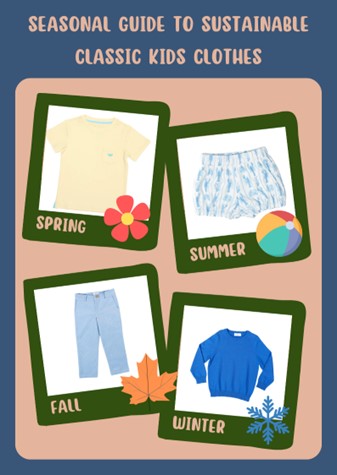
Tips for Finding Sustainable Classic Kids Clothes for Every Season
Are you struggling to find sustainable and stylish clothing for your growing children? Many parents face this challenge as they try to balance fashion, practicality, and environmental consciousness. Dressing kids in eco-friendly clothes doesn’t have to be complicated or boring.
By focusing on classic styles, durable materials, and versatile pieces, you can create a sustainable wardrobe that your children will love. This guide will help you with sustainable kids’ fashion. It offers tips for every season and addresses concerns about cost, style, and durability.
Sustainable Fashion for Kids
Before diving into specific tips, it’s essential to understand what sustainable fashion means in the context of children’s clothing. Eco-friendly materials, fair labour, and durable design make sustainable kids’ clothes a better choice. They often have a timeless appeal that transcends seasonal trends, making them perfect for hand-me-downs or resale.
Opting for sustainable children’s clothing offers numerous benefits. Sustainable clothes reduce waste and pollution associated with fast fashion. High-quality classic kids clothes last longer, saving money in the long run. Moreover, investing in these pieces supports brands that care about the environment.
Timeless designs can be mixed and matched easily, creating multiple outfits. Many sustainable brands prioritize fair labour practices and safe working conditions. Additionally, eco-friendly materials are often gentler on children’s sensitive skin.
Seasonal Guide to Sustainable Classic Kids Clothes
Spring
Spring is a season of renewal, and your child’s wardrobe should reflect this fresh start. Look for organic cotton basics like plain t-shirts in neutral colours, light sweaters for layering, and comfortable leggings or joggers. These versatile pieces can be mixed and matched throughout the season and even into summer.
Invest in quality denim, such as jeans or shorts, from brands that use sustainable production methods. Opt for a high-quality, water-resistant jacket made from recycled materials for unpredictable spring weather.
Summer
Summer calls for lightweight, breathable clothing that protects delicate skin from the sun. Choose clothes made from natural fibres like organic cotton, bamboo, and linen to keep kids cool. Prioritize sun protection by investing in clothing with built-in UV protection, such as rash guards and wide-brimmed hats made from recycled materials.
Look for multi-functional swimwear that can double as regular clothing, like board shorts that work as casual shorts or swim shirts that can be worn as regular tops. Opt for chlorine-resistant, recycled fabrics for longevity.
Fall
Fall is all about layering, making it an excellent season for sustainable fashion. Invest in quality knitwear made from sustainable materials like organic wool, recycled cashmere, or organic cotton blends. Choose classic styles and neutral colours that can be paired with multiple outfits.
For bottoms, opt for durable, comfortable options that can transition from early fall to late autumn, such as corduroy pants made from organic cotton or leggings made from recycled materials. As temperatures drop, focus on outerwear made from eco-friendly materials like jackets insulated with recycled polyester or vests made from organic wool.
Winter
Winter presents unique challenges for sustainable fashion, but there are still plenty of options for keeping kids warm without compromising on ethics. Look for winter coats and snowsuits that use eco-friendly insulation, such as recycled polyester fill or organic wool. Ensure the outer fabric is water-resistant and durable for longevity.
Invest in quality boots made from sustainable materials like natural rubber, with features like replaceable liners to extend wear. Complete the winter wardrobe with sustainable accessories like hats, scarves, and gloves made from organic wool or recycled materials.
Accessories and Footwear
Accessories and footwear are crucial components of a sustainable wardrobe. Look for shoes made from recycled or natural materials, such as organic cotton, natural rubber, or recycled plastics. Many sustainable options offer stylish and durable choices that can withstand the wear and tear of active children.
For accessories, choose items like backpacks, hats, and scarves made from eco-friendly fabrics. These can add a touch of personality to any outfit while supporting sustainable practices. Additionally, consider multifunctional accessories, like reversible hats or scarves, which can provide different looks with one item.
Sustainable footwear often includes features like replaceable liners and soles, extending the life of the product and providing better value. Educating children about the benefits of these choices can instill lifelong sustainable habits.
Benefits of Choosing Sustainable Clothes
Choosing sustainable clothes goes beyond just the materials used. These items often support ethical practices, ensuring fair wages and safe working conditions for their workers. By opting for sustainable clothes, you contribute to a more equitable and environmentally friendly fashion industry.
Moreover, sustainable clothes tend to prioritize quality, offering products that last longer and provide better value over time. This approach not only benefits the planet but also teaches children the importance of making mindful purchasing decisions.
Sustainable clothes often feature timeless designs that remain stylish season after season, reducing the need for frequent replacements. Additionally, many sustainable options use hypoallergenic materials, which are gentler on children’s sensitive skin, providing both comfort and peace of mind for parents.
General Tips for Year-Round Sustainability
Regardless of the season, there are some overarching strategies to keep in mind when building a sustainable, classic wardrobe for kids:
Prioritize quality over quantity by investing in fewer, higher-quality pieces that will last longer. Choose classic designs that won’t look dated after a single season, making clothes more suitable for hand-me-downs or resale.
Look for adjustable features in clothing, such as adjustable waistbands or roll-up sleeves and pant legs, to extend their usability as children grow. Don’t overlook the sustainability of second-hand shopping, as many classic, high-quality pieces can be found in consignment shops or online marketplaces.
Take the time to research brands thoroughly, looking for transparency in their production processes and materials sourcing. Finally, involve your children in the process of choosing sustainable clothes, educating them about the importance of making eco-friendly choices and caring for their garments.
| Feature | Conventional Kids’ Clothes | Sustainable Kids’ Clothes |
| Materials | Conventional cotton, synthetics | Organic cotton, recycled materials |
| Durability | Variable | Generally higher |
| Production | Mass-produced | Often small-batch or artisanal |
| Environmental Impact | Higher | Lower |
| Cost | Initially lower | Initially higher, but often more cost-effective long-term |
| Style | Trend-focused | Classic, timeless designs |
| Versatility | Variable | Often more versatile |
| Ethical Considerations | Often unclear | Usually prioritized |
Conclusion
Parents, we understand your concerns about finding sustainable, stylish, and affordable clothing for your children. By following these tips and focusing on quality, versatility, and timeless designs, you can build a wardrobe that’s good for your kids and the planet. Remember, every small step towards sustainability makes a difference. Create an eco-friendly closet for your kids and enjoy durable, classic pieces that last for a long time.
Frequently Asked Questions
How do I care for sustainable clothes to make them last longer?
Follow care instructions carefully, wash in cold water, air dry when possible, and mend small tears promptly. Use gentle, eco-friendly detergents and avoid overusing the dryer.
Can sustainable clothes be stylish too?
Absolutely! Many sustainable brands focus on timeless designs and high-quality materials. Mix and match pieces to create trendy outfits while maintaining a sustainable wardrobe.
How can I involve my kids in sustainable fashion choices?
Educate them about sustainability, let them choose from pre-selected sustainable options, encourage upcycling projects, and teach them to care for their clothes properly.
Article by Community Writer.
creditSource link





